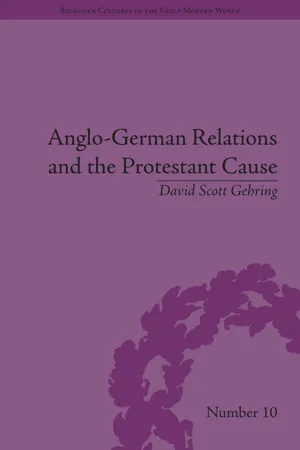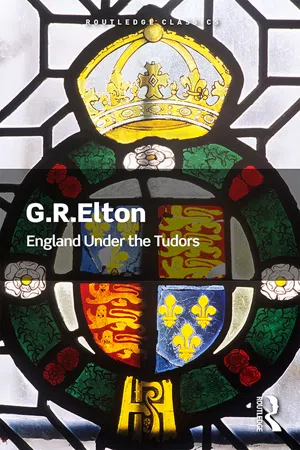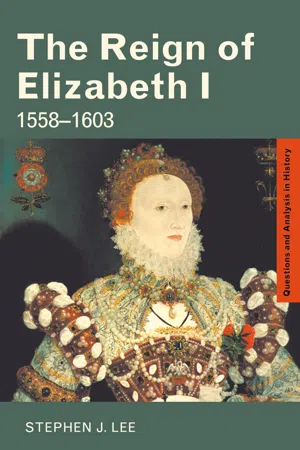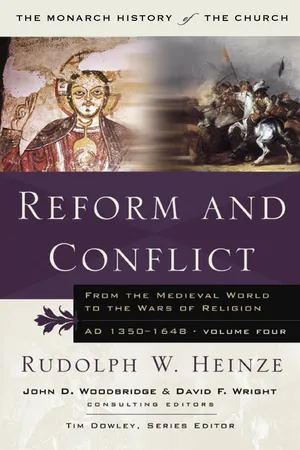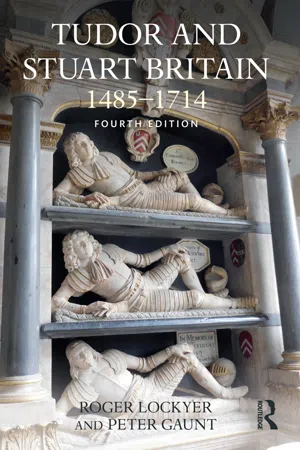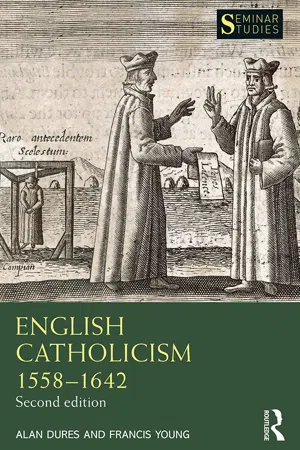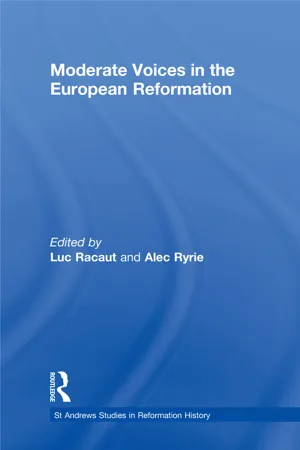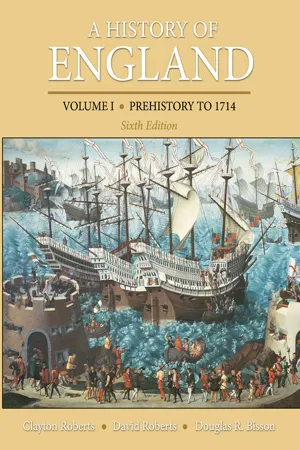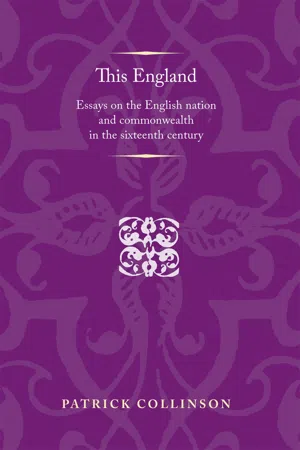History
Elizabethan Settlement
The Elizabethan Settlement refers to the religious and political compromises established by Queen Elizabeth I in the late 16th century to bring stability to England after the religious turmoil of her predecessors' reigns. It sought to create a middle way between Catholicism and Protestantism, establishing the Church of England as the official state church while allowing some elements of Catholic tradition to remain.
Written by Perlego with AI-assistance
Related key terms
Related key terms
1 of 4
Related key terms
1 of 3
10 Key excerpts on "Elizabethan Settlement"
- eBook - ePub
Anglo-German Relations and the Protestant Cause
Elizabethan Foreign Policy and Pan-Protestantism
- David S. Gehring(Author)
- 2015(Publication Date)
- Routledge(Publisher)
Thirty-Nine Articles and beyond. With a history and cause common with German Protestants, traditional English Protestants like the Queen and her Principal Secretary, William Cecil, understood the early years of the reign as an opportunity to unite divergent strands of the reformed world. Examining in such a light the multiple components of the Settlement helps to illuminate its theological ambiguity and openness to Lutheranism. Shifting from domestic to foreign affairs, this conservative pan-Protestantism fostered renewed contact and collaboration with potential German allies during matrimonial proposals and in diplomacy. These domestic and foreign developments resulted in a positive, lasting relationship.The Elizabethan Settlement
The debate on the initiative, direction and character of the Settlement of Religion has continued from the Parliament of 1559 to modern times.2 At the time, zealous Protestants returning from exile, many of whom sat in the House of Commons, favoured a Church of England on the Swiss model, especially either Z?or Geneva – one could consider this group the Left. At the opposite end of the spectrum – the Right – Catholics in the House of Lords hesitated to concede to the new direction, wary of Zwinglian or Calvinist radicalism. Somewhere left of the middle lay the theological and political tastes of the conservative Protestant establishment as represented by the Queen and Cecil. The via media of the Elizabethan Church has sometimes been understood as situated between Rome and Geneva, and its interpreters often bend its meaning to suit their own tastes. This conception of a ‘middle way’ is as vague as the authors of the Settlement intended. Retaining elements of traditional ritual and appearance for ‘comeliness’ and ‘order’, yet adopting classically Protestant doctrines on the Eucharist and Predestination, the components of the Settlement had multiple influences and were open to interpretation. At its core, a pan-Protestant ambiguity incorporated many different types opposed to Catholicism. It was not that the early Elizabethan Church and State were actually ‘Calvinist’, ‘Lutheran’ or ‘Anglican’. Rather, it was open and acceptable to all three – in that way the via media could be lauded as sweet moderation while criticized as leaden mediocrity.3 English receptivity to German Protestantism before and during the early years offers suggestive context for the formulation and implementation of the Settlement, from the Act of Supremacy to the Thirty-Nine Articles - eBook - ePub
- G.R. Elton(Author)
- 2018(Publication Date)
- Routledge(Publisher)
Before the book was agreed parliament had reassembled (3 April). On the 10th the government produced a third supremacy bill identical with the second except that it substituted for the title of supreme head of the Church that of ‘supreme governor as well in all spiritual or ecclesiastical things or causes as temporal’. The widespread feeling against a female head had taken effect. In this form the bill was passed rapidly through the commons and more slowly through the lords. On the 18th the commons gave a first reading to the uniformity bill which authorised the agreed Prayer Book; within a few days it had passed both houses—the lords by a majority of only three with the spiritual peers solidly against it and several lay peers also opposing the government—and on 8 May Elizabeth, dissolving this momentous parliament, gave her assent. The Elizabethan Settlement was made. It now consisted of an act of supremacy enforcing the renewed break with Rome and the queen’s position as supreme governor of things temporal and spiritual, and an act of uniformity enforcing a protestantism not quite so clear-cut as that of 1552 but much more extreme than that of 1549. It is usual to call this settlement a compromise, and so it was—but not quite in the sense commonly supposed. Contemporaries did not think that the established Church rested halfway between the rival denominations: they thought this was a protestant Church. Episcopacy had not yet become an issue: even Knox accepted bishops. It was only the further development of puritanism (whose Coxian representatives were moderately content in 1559), as well as Elizabeth’s diplomatic suggestions to a number of deliberately blind Spanish and French emissaries that her protestantism was after all quite like catholicism, that disguised the nature of the settlement. The compromise was between the queen and her protestant subjects represented in parliament, and it involved greater concessions from her than from them. In this first round of the long parliamentary struggle over religion, the queen came off worst; the puritan minority displayed their characteristic tenacity and tactical skill; and England at once got a protestant Church despite Elizabeth’s desire for a gradual exploration of the way.The settlement involved two constitutional issues worthy of attention. In the first place, it assigned to parliament a place which it did not hold under Henry VIII but had acquired under Edward VI. The act of supremacy—like Henry’s similar act—gave to the sovereign all such jurisdictions and powers ‘as by any spiritual or ecclesiastical power or authority hath heretofore been … exercised’ in the government of the clergy; but it further expressly participated in the use of such powers by authorising their delegation. The act of uniformity stood on the principle first accepted in 1549 that the recognised legal form of worship was not only enforced but actually authorised by statute. Neither Cromwell’s vicariate-general or vicegerency, nor the settlement of doctrine by such royal instruments as the King’s Book of 1543, was therefore possible under the new dispensation. When Elizabeth delegated her ecclesiastical powers to successive commissions, those commissions’ doings could be challenged by reference to the act of 1559; this happened and caused much trouble. Similarly, the Prayer Book could not be altered without parliament, and parliament had a perfectly sound case for claiming a share in deciding the official ritual and doctrine: it had done so once at the queen’s invitation, and it was difficult to prevent ardent men in the commons from supposing that it could do so again on their unofficial initiative. The statutory character of the settlement—which could not be avoided—and the phrasing of the act of uniformity ended the queen’s exclusive control of Church and religion, whatever she might say. - eBook - ePub
The Reign of Elizabeth I
1558–1603
- Stephen J. Lee(Author)
- 2020(Publication Date)
- Routledge(Publisher)
There has always been a tendency to see the 1559 religious settlement as one based on moderation – the result of a compromise put together in difficult conditions and changing somewhat between its inception and its completion. Even so, there is plenty of scope for controversy as to the key influences behind and ingredients of the settlement. There is, for example, disagreement over the extent of the personal influence of the Queen herself, or over the prevailing influence of ideology at the time, or over the entrenched power of institutions such as the House of Commons and the House of Lords. Or, if the settlement is seen as a combination of all three, what are their relative proportions: was it a balanced or a lopsided combination? Also important are the broader perspectives on Tudor religious change. Was the 1559 settlement a resumption of the more moderate doctrinal trends of Henry VIII after interruptions from the more radical changes of Edward VI and Mary? Alternatively, was Elizabeth more in line with Edward VI, restoring Protestantism after Mary’s attempts to destroy it? Or perhaps the 1559 settlement made concessions to both radicals and conservatives, restoring Protestantism while acknowledging that this had at least been diluted by the reign of Mary.Sometimes historiographical changes are strikingly different in their evolution. In this particular case, however, interpretations have developed in a subtler way.During the late nineteenth century, and indeed for the first half of the twentieth, there was a broad consensus that the Elizabethan religious settlement constituted a middle way – a ‘via media’ – between more radical alternatives. The moderate nature of the settlement was taken for granted, although there was some disagreement about exactly why common sense should at last have prevailed and the extremes have been pushed to their rightful place at the periphery.One possibility is that the time was right for a compromise between a new Protestant monarch and the conservative remnants of the previous reign. Elizabeth’s own views were distinctively Protestant, a legacy from her mother, Anne Boleyn, and from the Boleyn faction at court. They were reinforced by her upbringing and education organised by Catherine Parr, Henry VIII’s last wife. It would seem, then, she had a closer affinity with the religion of her half-brother, Edward VI, than with that of her half-sister, Mary, or her father, Henry VIII. Wherever possible, therefore, Elizabeth held out for a Protestant settlement – but not for one which would incite resistance from the traditionalists. In other words she was a reforming force trying to pull back the initiative lost to the conservatives during the reign of Mary. The result was bound to be a compromise. An alternative slant to the traditional view presents Catholic influence in a more positive light. This originates very much from the long Catholic tradition within England and was reinforced by the influence of the Oxford Movement in the nineteenth century, which saw the conversion of a number of prominent Anglicans to Catholicism. The emphasis is very much on Elizabeth recognising the constructive features of Catholicism and the achievements of the reign of Mary; Elizabeth therefore saw the sense of preserving at least some of them. A third view – again very different – is that Elizabeth had no religious commitments at all. She was, according to A.F. Pollard, ‘sceptical or indifferent in religion’,1 while J.R. Green considered her ‘almost wholly destitute of spiritual emotion’, untouched by ‘theological beliefs and controversies’ and seeing everything in ‘a purely political light’.2 - eBook - ePub
Reform and Conflict
From the Medieval World to the Wars of Religion, AD 1350-1648, Volume Fo
- Rudoph W. Heinze, Tim Dowley(Authors)
- 2012(Publication Date)
- Monarch Books(Publisher)
The significance of the change was that it enabled those who believed in a real presence of Christ’s body and blood in the Eucharist, which included Calvinists and Lutherans, to read their theology into the 1549 words. On the other hand Zwinglians, who viewed the sacrament as a memorial feast in which the bread and wine were mere symbols, could focus on the 1552 words, which emphasize the memorial aspects of the sacrament. The third addition, the “ornaments rubric,” was to be a source of ongoing controversy in the years that followed. It was understood as providing for the restoration of the vestments that were in use in the 1549 prayer book, which would have helped Catholics to worship using the prayer book because at least in ministerial dress the service resembled the Catholic service, but more extreme Protestants were not happy with vestments associated with the priests of the medieval church because they associated them with the doctrine of the sacrificial mass. Another ingredient of the settlement was a theological statement called the Thirty-nine Articles, which was adopted in 1563. It was a revision of the earlier Forty-two Articles, dropping certain statements, including the specific denial of the real presence in the Eucharist.Although the settlement had been established by 1563, most scholars agree that England was still a long way from becoming a Protestant country. Even the justices of the peace, who were expected to enforce the settlement, were not reliable Protestants. In 1564 an inquiry into their religious beliefs revealed that “scantly a third part was found fully assured to be trusted in the matter of religion.”27 The church also lacked an educated preaching ministry who might be able to convert the kingdom to the Protestant faith. For example, the bishop’s visitors gave the following report on the Sussex churches in 1559: “Many churches there have no sermons, not one in seven years, and some not one in twelve years, as the parishes have declared to the preachers that of late have come thither to preach. Few churches have their quarter sermons according to the Queen’s Majesty’s injunctions…. The ministers there for the most part are very simple.”28When Elizabeth became queen, the zealously Catholic Marian bishops and the most committed priests resigned their posts. All the bishops, except the obscure bishop of Llandaff, refused to take the oath of supremacy, so they were deprived and replaced with Protestants. About four hundred other Marian clergy either resigned their posts or were deprived between 1559 and 1564. In order to fill the vacant episcopal posts, Elizabeth had to rely heavily on the returning Marian exiles, some of whom had adopted a more radical form of Protestantism during their Continental sojourn in cities where Calvinism or Zwinglianism prevailed. She did, however, manage to find a man to serve as archbishop of Canterbury who was not tainted by a stay on the Continent during the Marian period. Matthew Parker (1504–1575), who had been one of Anne Boleyn’s chaplains and held the post of dean of Lincoln at the end of Edward’s reign, had stayed quietly in England during Mary’s reign and managed to survive. He was Elizabeth’s choice for the most important position in the English church, both because of his identification with her mother and because he had not been a Marian exile. Parker proved to be an outstanding choice, and he led the fledgling Elizabethan church through the first decade and a half of its existence. - eBook - ePub
Tudor and Stuart Britain
1485-1714
- Roger Lockyer, Peter Gaunt(Authors)
- 2018(Publication Date)
- Routledge(Publisher)
It remains very unclear not only how closely the religious and Church settlement eventually achieved in 1559 accorded with the government’s goals at the start of the process but also how far and in what ways that settlement represented the wishes of the Queen, of Cecil – now generally viewed as an important religious reformer – and of other key individuals and groups who were involved. Historians continue to debate both questions and offer very different answers. What is reasonably clear is that the Queen viewed the 1559 settlement as just that – a firm and more-or-less final settlement of the issues – and thereafter was unwilling to go much further or to make any significant changes. In contrast, other interested parties saw 1559 as unfinished business, as an important and major step towards a fully reformed Church but no more than that, and as something to be built upon with further measures necessary to achieve a still-elusive complete reformation. Much of the religious history of Protestantism and the Church during the rest of Elizabeth’s reign can be understood within that framework and many of the religious tensions that arose over the next few decades can be traced back to those contrasting views of what the 1559 settlement represented.The Puritan challenge
Although there were a number of features of the Elizabethan religious settlement that were unpalatable from the point of view of the returned exiles – and, for that matter, of many people of similar outlook who had remained in England during Mary’s reign – there was a widespread assumption that they were merely a matter of form and would not be strictly implemented. Nevertheless, their continued existence was an affront to those who were to be called ‘Puritans’ because they wanted the Church to be cleansed or purified of all traces of Catholicism. When Convocation met in 1563, a group of Puritan ministers introduced articles designed to eliminate these undesirable features. They called for the abolition of holy days other than Sundays and the principal feasts, such as Easter, and for the removal of organs from churches. They demanded that ceremonies such as kneeling to receive communion and signing with the cross in baptism should be left to the discretion of the minister, and that compulsory vestments should be confined to the surplice, which they regarded as the least obnoxious of the prescribed garments. However, when the Puritan articles were put to the lower house of Convocation, which represented the bulk of the clergy, they were defeated by 59 votes to 58, and at the same time there was mounting pressure for all ministers to conform to the rules laid down in the Prayer Book and Injunctions. - eBook - ePub
- Alan Dures, Francis Young(Authors)
- 2021(Publication Date)
- Routledge(Publisher)
1 Catholics in early Elizabethan England, 1558–1572DOI: 10.4324/9781003130376-2Elizabeth I’s decision to abandon the religious policy of her half-sister Mary I in favour of a Protestant religious policy was the act that created a minority of English people who chose to identify themselves as Catholics. However, the piecemeal enforcement of the Elizabethan Religious Settlement in the 1560s enabled many Catholics to practise their faith with the assistance of priests ordained in the reigns of Henry VIII and Mary. Nevertheless, some of the early contours of English Catholicism emerged at this period, such as the appearance of both recusants and church papists. However, events in the late 1560s and early 1570s hardened the government’s attitude towards Catholics and made it increasingly difficult for Catholics to practise their faith. The period 1558–72 was a crucial, formative yet uncertain time for England’s Catholics.Accession, religious settlement, and diplomacy
At the beginning of Elizabeth’s reign in November 1558 England was a divided nation, but almost certainly one in which the majority was attached to traditional religion. Nicholas Sander, an early Catholic exile in Louvain, claimed in 1561 that less than one per cent of the population was ‘infected with heresy’, although this seems well wide of the mark. Despite the successful Catholic restoration under Mary, there were strong pockets of Protestantism in London and the southeast, soon to be invigorated by the return of Protestant exiles from Europe; these exiles brought with them the reformed theology from radical centres such as Frankfurt, Strasbourg, or Geneva. It was clear from the early weeks that Elizabeth would opt for a form of Protestantism, but even the committed Protestants advising the queen recognised the problems of a divided nation. Nicholas Throckmorton advised Elizabeth that while authority was being established ‘it shall not be meet that either the old or new [religion be] fully understood’. William Cecil was bolder in pushing a Protestant agenda, but, recognising the twin threats of foreign Catholic powers and domestic conservative religion, he appreciated that skilful political manoeuvring would be required. The imperial ambassador, Count Helffstein, reported in March 1559 that Elizabeth ‘seems both to protect the Catholic religion and at the same time not entirely to condemn or outwardly reject the new Reformation’ [Doc. 1, p. 120] - eBook - ePub
- Luc Racaut, Alec Ryrie(Authors)
- 2017(Publication Date)
- Routledge(Publisher)
CHAPTER TWO A Diagnosis of Religious Moderation: Matthew Parker and the 1559 Settlement Louise Campbell Over the centuries the Elizabethan religious settlement of 1559 has been the subject of much debate. In the past historians focused on the questions of what kind of religious settlement Elizabeth and her advisers wanted following her accession in November 1558, and how close the settlement achieved in parliament in the spring of 1559 was to the settlement they had envisaged. Were the queen and her advisers held back by Catholic opposition in the House of Lords or were they pushed too far in a Protestant direction by proto-puritans in the House of Commons? 1 Regardless of whether the regime and the queen got the settlement they wanted, historians seem unanimous in their description of the settlement; it was a via media, a moderate religious settlement implemented by the embodiment of moderation, Archbishop Matthew Parker. From the first weeks of Elizabeth's reign her chief ministers William Cecil and Nicholas Bacon were determined that Parker, their old associate, would become the new archbishop of Canterbury. The regime was fortunate that Cardinal Pole, the previous Archbishop, had died 12 hours after Mary I in the evening of 17 November 1558; for Pole, a staunch Catholic, would have presented a difficult problem for the new regime. The candidate chosen to be the new archbishop would signify to the world the nature of Elizabethan religious policy Historians, from John Strype in the eighteenth century to William Haugaard in the twentieth, seem united in believing that the key to Parker's appointment as archbishop in 1559 was his moderation. 2 Surprisingly, however, despite the almost universal use of the term 'moderate' there has been little discussion of what 'moderate' in this context really means. This essay will attempt to diagnose the kind of religious moderation found in Matthew Parker and the religious settlement of 1559 - eBook - ePub
A History of England, Volume 1
Prehistory to 1714
- Clayton Roberts, F David Roberts, Douglas Bisson(Authors)
- 2016(Publication Date)
- Routledge(Publisher)
(National Portrait Gallery, London. The Bridgeman Art Library Ltd.)The first task facing the Queen and her Council was to settle the religious question. Elizabeth herself was not committed to any creed; indeed, she kept her religious convictions so private that historians have wondered if she had any. What is certain is that she was guided in the settlement of religion by a desire to restore unity among her subjects. She knew that she could not choose Roman Catholicism, because too many of her subjects hated Rome. She might have preferred Henrician Catholicism, but this was impossible since there were no longer any clergymen who would support the mass without Rome. The only alternative was to turn to Protestantism.To this end the government introduced into Parliament in 1559 an Act of Supremacy and an Act of Uniformity, the first making Elizabeth, not the Pope, the supreme governor of the Church and the second requiring the use in every parish of a Book of Common Prayer based upon the Prayer Book of 1552, though modified to satisfy the Queen's more conservative views. The two great obstacles to this new settlement were the Catholic bishops and some conservative lay peers in the House of Lords. The lay peers, though not the bishops, acquiesced in the renunciation of the Pope's supremacy, but the lay peers balked at any major alteration in Catholic worship. The government, therefore, took measures to secure the passage of the Act of Uniformity through the Lords. It arranged during the Easter recess a theological disputation, heavily weighted toward the Protestant side. It imprisoned some of the more outspoken Catholic bishops and discouraged others from attending the House. It then introduced into the Lords its Act of Uniformity, which passed by the slim margin of three votes. The Queen, with the help of the House of Commons, had obtained a Protestant religious settlement. - eBook - ePub
Early Modern England 1485-1714
A Narrative History
- Robert Bucholz, Newton Key(Authors)
- 2019(Publication Date)
- Wiley-Blackwell(Publisher)
CHAPTER FOURThe Elizabethan Settlement and Its Challenges, 1558–1585The New Queen
Perhaps no figure in English history has inspired more myth than Queen Elizabeth I (reigned 1558–1603).1 She had many personas: the Virgin Queen, Gloriana, Good Queen Bess to her supporters; the bastard and heretic daughter of that whore, Anne Boleyn, to her detractors. In her day, scores of poets and artists promoted these various images (see Plate 4.1 ). Since then, legions of writers, some scholarly, some popular, as well as playwrights and filmmakers, have sought to relate the achievements of her reign and explain the mystique she exercised over her people. She herself was well aware of that mystique, cultivating it so effectively that it is almost impossible to pin down the “real” Elizabeth. Still, it is necessary to try, if only because so many of the age's triumphs and failures were intimately bound up with her words and actions.One place to begin is with her accession on 17 November 1558. According to legend, all England rejoiced, as if anticipating the glories to come. True, few openly grieved Mary's passing and committed Protestants, especially in London, celebrated outright, for they had been delivered from the Marian persecutions. Elizabeth's advisers and supporters proclaimed the dawn of a new, more optimistic and glorious age under a queen who would bring harmony and peace. But such predictions must have seemed hollow given the times. One contemporary summed up the situation inherited by the new regime as follows: “The Queen poor. The realm exhausted. The nobility poor and decayed. Want of good captains and soldiers. The people out of order. Justice not executed. All things dear. The French King bestriding the realm.”2Indeed, in 1558 England was still embroiled in a disastrous war with France. Calais had been lost and trouble threatened on the Scottish border. The royal treasury was deep in debt, the coinage debased, trade depressed, the general economy in ruins. The mid‐to‐late 1550s saw lots of rain, a run of bad harvests, and an influenza epidemic that led to some of the highest mortality rates of the period. Nor was religion of much consolation as the nation lay divided, torn, and almost literally bleeding over how best to worship God. Finally, given contemporary assumptions about the sexes, who could have believed that these problems would be solved by another woman? Mary's reign had done little to disprove the traditional view of female sovereignty. As if to underscore this, in this very year of 1558 a Scottish Protestant preacher named John Knox (ca. 1514–72) published The First Blast of the Trumpet Against the Monstrous Regiment of Women, the argument of which should be obvious.3 - eBook - ePub
This England
Essays on the English nation and Commonwealth in the sixteenth century
- Patrick Collinson(Author)
- 2013(Publication Date)
- Manchester University Press(Publisher)
Other religious and ecclesiastical misdemeanours invited excommunication. That was a religious matter, but it had political and social implications. So far was religion from being private or voluntary that you could be put to death by incineration for the simple offence of holding beliefs which were contrary to orthodox Christianity. It did not happen very often, but it still happened, so far as we know, to eight persons between 1575 and 1612. 4 Political interest in religious belief and practice was not, of course, an Elizabethan innovation. Readers of Eamon Duffy’s brilliant and hugely influential book The Stripping of the Altars might be forgiven for gathering that the politicisation of religion began with Henry VIII. 5 But it was much older than that, and had been ratcheted up by the Lancastrian kings, using the threat of heresy and an act of parliament dealing with heresy to bolster their dubious entitlement to the throne. Henry VIII merely moved the goalposts and changed the rules. Since parliament had made the religious settlement, it could presumably unmake it, or change it (that had happened several times before, since the 1530s), and many sessions of successive Elizabethan parliaments were dominated by the politics of what Protestant critics of the settlement called ‘further reformation’. Parliamentary campaigns to improve the state of the church, by reforming the prayer book, or even changing the very structure of the church, but above all to promote what hot Protestants called a godly preaching ministry, involved some precocious parliamentary politics. The religion of politics and the politics of religion in Elizabethan England in this sense meant a lot of work at the grassroots, gathering evidence and forwarding it to Westminster; petitions claiming to speak for the people of England; procuring the election of the right sort of Members of Parliament; and the lobbying of Members by what we would call pressure groups
Index pages curate the most relevant extracts from our library of academic textbooks. They’ve been created using an in-house natural language model (NLM), each adding context and meaning to key research topics.
Explore more topic indexes
Explore more topic indexes
1 of 6
Explore more topic indexes
1 of 4
